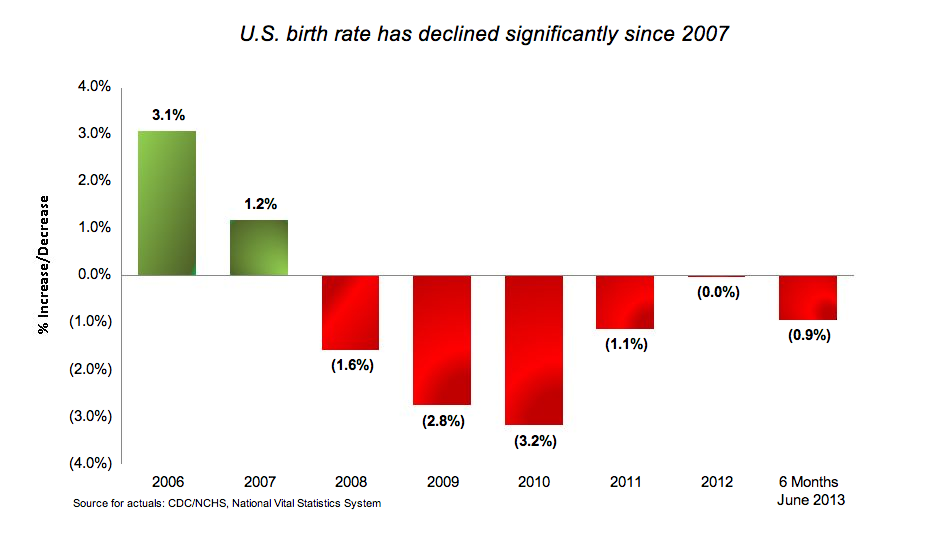CHART OF THE DAY: The Falling US Birth Rate
For today's chart - take a look at the how the USA birth rate has been declining over the last several years, and after the chart, and for no additional costs, I will drop some comments about what, if anything, this might mean for you, the HR/Talent pro:

What might this mean, or at least suggest?
1. Your first reaction is that it means nothing. Who cares if there are relatively fewer kids being born right now? This won't impact labor markets for at least another 15 years or so and by then, who cares? A robot will be doing your job by then anyway, right?
2. But it is not just the sources of candidates/employees that matter or should matter to you. If your business has anything to do with selling products or services to the baby/youth/teen markets, then this trend is going to impact you. And if you think, 'We make industrial products that go into new home construction so this does not affect us', you might want to think again. The declining birth rate shouldn't be considered in a vacuum - their are related trends in marriage rates and ages of first marriage, household formation, and related spending at play here as well. Long story short, Americans are getting married less, are older when and if they do get married, are having fewer children, and are having them at more advanced ages than in the past.
3. This combination of a decline in birth rate and rise in the average age for both first marriages and having children will, if it has not already, influence your workforce planning processes in a few ways. You might be able to project a decrease or at least a reduction in the rate of increase in your benefits costs for covered dependents in the next few years, as your employees are covering fewer kids than in the past. Your succession planning processes may need to be re-emphasized if later career employees begin leaving (or simply taking leave) for child care reasons. These later career employees, say in their late 30s and up, are likely to have more senior and important roles in your company. Finally, if you are really and truly thinking long-term, say out 10-15 years, larger and wider demographic trends could effect things like expansion plans and ability of organization to move into new markets.
Perhaps I am stretching credibility by suggesting that you should really be worried about a probably caused by the 2007-2008 recession down trend in the birth rate when you have much more immediate and pressing concerns.
But I still find this kind of data fascinating, and even if you can't find an immediate or even medium-term impact of these bigger trends, I think they are worth recognizing. If nothing else you will at least know why the local school board wants to consolidate your elementary schools in the next few years.
Happy Thursday.

 Steve
Steve
Reader Comments (6)
At 41, we're adding a third kid... more than ten years after the last. That drastically changes our outlook and priorities on work/life, investing, etc.
Congrats and good luck!
Feminists and the liberals that support them would never allow it. But then liberal feminism combined with the rise of the new atheism is what has done the family in. Men no longer want the liability of marriage and children and as atheists they don't believe that affects them past the few short years they have left here. Ideology matters because what people think and believe affects what they do. When the male birth control pill is released it's over for Western Civilization. Agreed. The Muslims will inherit the earth by default as they'll be the only ones having babies and the world will descend into the darkness of violent Islamic expansion once again. They murdered about 70 million Hindus alone during their last expansionary period with nothing but swords and melee weapons. Now they'll have technology.
It also impacts the sustainability of entitlement programs like social security. Right now it takes at least four young workers to maintain the monthly payments of one retiree. Who is going to be supporting the generation after us boomers?
Interesting when you considering HR Tech also. When you consider that robots will replace more "automated" tasks, and the work force becomes more refined. Does this mean HR Tech will have to focus more on Quality than Quantity?
Also recruiting will have less applicants (if the population decreases) meaning we might have to go back to a more detailed look at whom is applying - rather than key word elimination?
Just some thoughts. Once again this is just crystal ball gazing.....as I am talking if this trend continues for the next 10-20 years.
What a fascinating chart. I had no idea the rate was falling. Can you tell us the absolute number? Do you think the US runs the risk of a badly-distributed, aging population such as Japan’s? Although you say we may have more urgent concerns right now, I rather believe that it’s important to plan for the future. This sort of data allows us to do it. Plus it does have an immediate impact: healthcare, maternity leave, life-style and ways of working will all be affected by people choosing to have fewer babies or having them later. HR needs to have its eye on the horizon as much as dealing with the day-to-day.